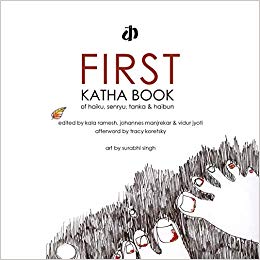It’s a delight to see a Katha Book on a much-loved theme- Haiku and allied forms of poetry. Poetry has been embedded in our collective consciousness and this collection picks some true gems from about 35 Indian poets.


The world of poetry is enthralling. Come to think of it, is it not a wonder that one can crystallise an entire line of thought, or a human experience in just a few words? Yes, by saying so little a poem can say so much. Amongst the varied forms of poetry, Haiku, an old Japanese form of poetry has been immensely popular. While I have read Haiku collections before, reading the First Katha book of Haiku, made me aware about the immensely rich contribution that Indian poets have made to the Haiku traditions. Yes, this book presents Haiku from India, curated beautifully, with elegant illustrations by Surabhi Singh.
Did you know that some of the greatest Indian poets such as Rabindranath Tagore and Subramania Bharati were early proponents of Haiku poetry in India? And that Indian poets have written a treasure trove of haiku poetry in regional languages? Well, this book brings some beautiful verses in English for readers to appreciate the haiku tradition from a different angle.
The form of Haiku never ceases to amaze me. It is all about “Show, don’t tell”. Reading a Haiku can be a very enlightening and almost spiritual experience, and I am sure that as you read this book you will experience some of those moments.
Haiku from India
Diwali night
the new year begins
with old folk tales
Gautam Nadkarni
One of the distinguishing aspects of this book is the fact that the themes of the poems are so easily Indian, since they are born of Indian experiences. So, in form and structure, they are true to the Haiku essence. In content, one can easily see the uniquely Indian experience. Just glance at the following examples which are so easily identifiable in the Indian context.
late for school
the green mangoes still
out of reach
Angelee Deodhar
parched field
a tattered scarecrow
still on vigil
Sunil Uniyal
Of course, while the nuances that stem from the “Indian” experience make the book a pleasure to read, one must also remember that ultimately poetry transcends geography and time. Poetry is all about the human experience that any person from any culture will identify with.
circus clown
show over, he pulls off
his painted smile
Kala Ramesh
The book also talks about a few other forms of poetry allied to Haiku. These include Senryu, Tanka and Haibun. There is an explanatory chapter at the end for those who are keen on knowing more about these forms. The afterword focuses on some of the specific aspects of the poems and styles presented in the book.
Who should read it…
I think that anyone with a general interest in poetry would find this book very accessible. If you’re specifically fond of Haiku, then this is a must read. Students of literature will also find the notes super helpful and of great academic interest. If you’re beginning to read poetry, this is a simple and profound book that will be a great passage way to the world of poetry.
The verses in the collection span Haiku, Haibun, Senryu and Tanka. What binds them all together and makes the collection so endearing is the simplicity of the words and the profound impact they have on the reader. It’s not very often that you come across a book where nuances take over and the reading becomes a sublime experience!




